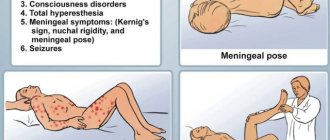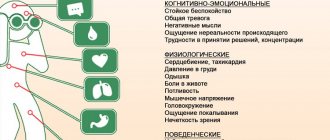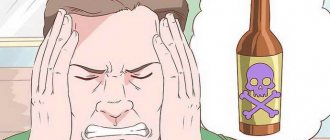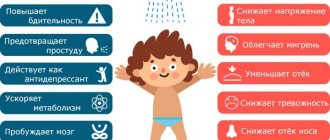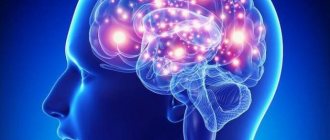Panic attacks in children are sudden, provoked or causeless attacks of fear, accompanied by autonomic disorders. The attack lasts up to minutes, anxiety turns into panic, blood pressure rises, breathing and heartbeat quicken, and tremors of the limbs occur. Disorders of the digestive tract and urinary system are often observed. The main diagnosis is carried out by a psychiatrist and, if necessary, supplemented by an examination by a clinical psychologist or neurologist. Treatment includes the use of medications to stop attacks and psychotherapy to prevent their subsequent development.
Children are usually much more sensitive physically and psychologically than adults. Every person faces certain fears in their life, but children are more defenseless due to their age and lack of experience. Panic attacks in children require treatment to avoid serious consequences.
Classification of panic attacks in childhood
Depending on the number of manifestations:
- Large (full-scale) attack - four or more symptoms.
- Minor attack – less than four symptoms.
Depending on the prevailing manifestations:
- Typical (vegetative). Symptoms such as increased pulse and heart contractions, spasms, nausea, and fainting prevail.
- Hyperventilation. Main manifestations: increased breathing, reflex cessation of breathing.
- Phobic. phobias predominate . Fear arises in situations that, according to the patient, are dangerous and can provoke a panic attack.
- Affective. They manifest themselves in the form of depression, obsessive thoughts, constant internal tension, melancholy and angry states, and aggressiveness.
- Depersonalization-derealization. The main symptom is detachment, a feeling of unreality of what is happening.
What is a panic attack
A panic attack causes an unbearable physical condition, so the person enters a vicious circle of waiting for an attack - this is how panic disorder develops. PA usually occurs without any warning signs and sometimes without a specific trigger. The attack can be either one-time or repeated over a relatively short period.
Content:
- What is a panic attack
- The most common myths about the disease
- What you can and cannot say to a person with PA
Signs of PA appear suddenly and usually peak within 10 minutes. Very rarely an attack can last more than an hour; in most cases it ends within 20-30 minutes. An attack can occur anywhere and anytime: on the street, in a store, in a car, even when a person is sitting quietly at home on the couch and watching TV.
A panic attack usually begins with feelings of fear and anxiety. During this time, a person may experience any of the following 4 symptoms:
- accelerated heartbeat;
- suffocation;
- chest pain;
- shiver;
- uneven breathing;
- depersonalization and derealization;
- nausea and abdominal pain;
- fear of losing control;
- excessive sweating;
- feeling nervous;
- fear of death.
Although the exact causes of panic attacks are still unknown to researchers, as specialist observations show, the disease tends to manifest itself as a hereditary disorder. Scientists have also discovered a connection between attacks and global changes in a person’s life (wedding, birth of a child, entering a university, changing place of study/work, death of a loved one, incurable illness or serious injury).
After the first attack of PA, it is very important to undergo examination and exclude possible other diseases. A panic attack can sometimes be caused by mitral valve prolapse (when one of the heart valves does not close properly), hyperthyroidism (an overactive thyroid gland), or hypoglycemia (severely low blood sugar). In addition, attacks of PA can occur after taking stimulants, including amphetamines, cocaine, and even drugs containing high doses of caffeine. In some people, PA may be a consequence of drug withdrawal.
Is it possible to outgrow PA?
Some dads and moms hope that a panic attack, like a hysteria, will simply go away on its own with age. But doctors warn: if PA is not treated, it will develop into panic disorder, mental illness, and will interfere with the teenager’s ability to socialize, build relationships or a career.
That is why parents need to know the symptoms of PA in their child:
- rapid heartbeat and frequent shallow breathing;
- pale skin;
- perspiration on the palms, back;
- complaints of nausea, stomach cramps;
- tremor of the limbs;
- headache or dizziness.
These symptoms indicate problems with the autonomic part of the nervous system and require qualified therapy.
What happens to the child?
During a panic attack, something like this happens in the human body:
- A sharp surge of adrenaline.
- The consequence is vasoconstriction, increased breathing and heart rate.
- Increased blood pressure.
- Rapid breathing increases the release of carbon dioxide, which further increases anxiety.
- Carbon dioxide changes the pH of the blood. This leads to dizziness and numbness of the limbs.
- Vasospasm slows down the delivery of oxygen to the tissues: lactic acid accumulates, increasing the manifestation of the attack.
Causes
Panic attacks in children, causes
- Parental overprotection, instilling increased anxiety when raising a child, constant control over personal time, studies, and the child’s health.
- A family where the parents have some form of chemical dependence (alcoholism, drug addiction), which often leads to conflicts.
- Emotional isolation of a child in the family occurs when parents do not pay enough attention to their children, and the child lacks emotional contact with one or both parents.
- Constant conflicts in the family between relatives for various reasons: psychological incompatibility, everyday problems, betrayal, etc.
- External factors: high competition at school, fear of ridicule, misunderstanding, fear of mistakes, etc.
- Children's fears: fear of the dark, fear of abandonment, etc.
- Physiological reasons: overwork, somatic diseases, etc.
For a child, his family is the whole world, and the climate in the family, how emotionally connected the parents are with the child, whether the child feels their love, largely depends on his emotional and mental state.
Cost of services
| TREATMENT OF DEPRESSION, NEUROSIS | |
| NAME OF SERVICE | price, rub. |
| Consultation with a therapist (observation) | 3,000 rubles |
| Consultation with a neurologist (observation) | 3,000 rubles |
| Consultation with a psychologist | 2,000 rubles |
| Psychiatrist consultation | 5,000 rubles |
| Consultation with the head of the department | 4,500 rubles |
| CONSULTATIONS, INITIAL INSPECTION | |
| NAME OF SERVICE | price, rub. |
| Telephone consultation | For free! |
| Telephone consultation for relatives | For free! |
| Initial consultation with a psychiatrist-narcologist in a hospital | For free! |
| Initial consultation with a psychologist by phone | For free! |
| Visit of a narcologist and consultation at home | 1,500 rubles |
| Consultation with a psychotherapist, psychologist in the clinic | 2,000 rubles |
| Initial appointment, examination by a doctor, cubital catheter, ECG | 2,500 rubles |
| Consultation with a therapist, neurologist, surgeon | 3,000 rubles |
| Family consultation with a psychologist | 3,000 rubles |
| Psychiatrist consultation | 4,000 rubles |
| Consultation with the head of the department | 4,500 rubles |
| PROMOTIONS AND DISCOUNTS | |
| When applying again | 5% discount on treatment |
| Disabled people and war veterans | 5% discount on treatment |
| Large families | 10% discount on treatment |
* Dear patients! The administration tries to promptly update the price list posted on the website, but in order to avoid possible misunderstandings, we ask you to clarify the cost of services on the day of your call by calling 24/7.
The posted price list is not an offer.
Symptoms of panic attacks
Moments of panic attacks in children occur spontaneously, without any apparent reason. They do not pose a threat to the children’s lives; they are characterized by vegetative disorders, including:
- feeling of dry mouth;
- pallor of the epithelium;
- increased anxiety;
- hypertension;
- increased sweating;
- ringing in the ears and fog before the eyes;
- trembling, numbness of limbs.
During an attack, children often experience tremor of the eyelids and lips, pain in the chest area, and dizziness. Also, with PA, they may experience nausea that is not related to nutrition. Often the attack ends suddenly, accompanied by significant urination (light urine with low relative density). Since children cannot always explain their condition, point out painful areas, as well as a variety of symptoms, the anomaly is not always diagnosed on time.
Causes of a panic attack
In the development of a panic attack, it is customary to distinguish 3 main factors: biological, physiological and psychogenic. In practice, combinations of several reasons are often encountered, when one factor is the main one and the other is secondary.
As a rule, sudden anxiety occurs against the background of mental illness. But besides this, attacks appear as a result of the following reasons:
- The period before and after childbirth.
- The time of bearing a child.
- The onset of menopause.
- Taking certain groups of medications.
- Tumor formation of the adrenal glands.
- Prior myocardial infarction.
- Ischemic heart disease.
- Early sexual life.
Obsessive states of anxiety and excitement can also appear as symptoms of certain pathologies:
- Depressive state.
- Various phobias.
- Diseases associated with the development of any hallucinations.
- Mental disorders arising from certain injuries after an accident.
- Obsessive-compulsive disorder is characterized by a constant feeling of fear of something. As a result, a person experiences obsessive actions that he repeats often and regularly.
Prognosis and prevention
The prognosis for panic attacks in children is favorable in the absence of comorbid conditions - anxiety, depression, hypochondria. The more tragic the child perceives the attacks, the more often they are reinforced by the anxious attention of parents and medical workers, the greater the likelihood of complications - agoraphobia, maladjustment in society. Prevention of panic disorder - creating home comfort, maintaining close family relationships. Emotional interest in the child’s life, moral support, and unconditional acceptance are important. Relapse prevention is based on periodic visits to a psychotherapist and taking medications without focusing on the disease. Statements like: “if you don’t take the pills, the attacks will start again” are unacceptable. In a tense school environment, it is worth discussing the presence of the disease with the school psychologist or class teacher.
First aid
First of all, during an attack, you need to calm down and begin to think that a panic attack does not pose a health hazard. No one has ever died from this.
You need to learn to control your breathing while breathing evenly and elongated. It helps to start counting or considering what is around.
If a loved one is nearby during an attack, then you need to take him by the hand and talk.
You must try to completely relax and think about good things. If you feel hot, you need to wash with cold water. If it’s cold, you can drink tea or take a warm shower.
Symptoms of a panic attack
Panic attacks are often a consequence of a mental disorder (schizophrenia, hysterical neurosis, depression, etc.) or somatic diseases (peptic ulcer, neurocirculatory dystonia, coronary artery disease, etc.). Psychological factors determine polysymptoms, as well as the presence of subjective and objective symptoms.
Often panic attacks have no connection with real danger. In this case, the disease takes a sudden start, the symptoms rapidly intensify, and then decline, leaving the patient alone with the state of recovery after the attack. Typically, panic attacks last about 15 minutes. In rare cases, short attacks (about 10 minutes) and long attacks (about 1 hour) have been observed. The most powerful attack is considered to be 5-10 minutes into its manifestation. Patients, recalling this period, complain of the particular severity of the attack, as well as a certain emptiness and depression.
The most common complaints are a feeling of suffocation, pain in the heart, cardiac arrest or excessive activity, breathing problems, lack of air, etc. Symptoms such as paresthesia, dizziness, chills, and sweating are often encountered. At the end of the attack there is polyuria. Patients often talk about cognitive impairment: depersonalization, unclear sound, blurry objects, lightheadedness, and so on. More rare symptoms are vomiting, belching, nausea and other gastrointestinal symptoms.
The first panic attack, with rare exceptions, is expressed by a specific fear of death. When repeated, it takes on a clear form: a person is overcome by the fear of death from some disease or accident. A feeling of anxiety appears, which is difficult to explain in any way, internal tension. Often patients reach a state of passion. Some patients are most susceptible to emotional disorders: feelings of pity, insignificance, hopelessness.
During panic attacks, certain functional disturbances may occur: twisting of the arms, chills, mutism, blurred vision, numbness of the limbs, changes in gait, etc.
Panic attacks in children: treatment
Since panic attacks in children can have both vegetative and psychological abnormalities, treatment of the disease involves alleviating both types of disorders. But parents should not expect quick results in this matter. The effectiveness of therapy can be achieved only after the factor provoking panic is discovered. As a rule, treatment is based on an explanation by a psychologist of how to behave during panic attacks and how they can be suppressed. If necessary, the child is assigned special sessions, during which the child develops a calm perception of the problems that arise in life, and changes his attitude towards himself and the world around him. As an addition to treatment, it is also common to use medications that help stop a panic attack.
Panic attack treatment
The main approach to treating a panic attack is the interaction of a psychologist and a neurologist, who jointly try to convince the patient on a subconscious level that a panic attack is not a disease, does not pose a risk to his life and health, and can also be controlled by the patient himself. Changing your perspective on various life situations is one of the most important aspects of recovery.
Antidepressants (tricyclic and tetracyclic) occupy a special place in drug treatment. However, their effectiveness does not appear for the first few weeks, and the symptoms of panic attacks during this period may become more pronounced. After about two months, the stage of maximum effectiveness of the drugs begins. Among the drugs, the most common are cipramil, fluvoxamine, fluoxetine, paroxetine, sertraline.
If desired, the patient can be prescribed various benzodiazepines. They do not increase the symptoms of a panic attack and are more effective from the moment of use, however, these drugs are not recommended for use for more than 4 weeks due to the risk of dependence on them. In addition, they are ineffective for depressive disorders. As a rule, these drugs are recommended for use to relieve paroxysms.
The choice of drug treatment method is entirely individual. As a rule, the course of drug use is 6 months or more. A complete cessation of the use of medications is relevant only in cases where the panic attack has not recurred within 40 days.
Breathing control is the simplest and most effective non-drug therapy. The patient needs to take as deep a breath as possible and hold his breath for as long as possible. After this, you need to exhale slowly. At the same time, you need to try to relax your body and close your eyes. This exercise is recommended to be repeated about 15-20 times. You are allowed to take a short pause of a few standard inhalations and exhalations.
Panic attacks in teenagers
Panic attacks in adolescents have a more pathological meaning and also often manifest themselves. We can say that teenagers are children at their core who are already participating in adult life. Therefore, while retaining childhood mental characteristics, they are already exposed to adult stress.
The etiology of teenage panic attacks is a combination of purely childhood causes of their occurrence and adults: stress, overexertion, psychological problems acquired by this time, and there are especially many unresolved interpersonal conflicts at this age.
Plus, there are certain teenage causes of panic attacks:
- Hormonal changes
- Periods of rapid growth, when the brain may perceive too sudden changes as a threat to life and health.
- Problems of establishing one's social status.
- A large number of certain physiological states: first menstruation, first sexual intercourse, first love, etc.
- Chronic and psychological disorders acquired by this time.
- Mental instability.
Pathogenesis of panic attacks
The causes of panic attacks are explained by several theories. The work of researchers in this matter is significantly complicated by the uncertainty of patients regarding the causes of the attack, as well as the inability to connect the traumatic situation and paroxysm. Because of this, there is no complete certainty regarding the causes of the disease. An additional complicating factor is the rapid progression of panic attacks and their sudden onset.
The most modern approach to the causes of panic attacks is the influx of anxious thoughts on the patient, which is not justified by absolutely anything. Under the influence of these thoughts, adrenaline and other catecholamines begin to be actively produced. As a result, blood pressure increases significantly and blood vessels narrow. Arterial hypertension during panic attacks affects even those people who have an absolutely normal premorbid background. Sodium lactate accumulates in the tissues, the concentration of CO2 gas in the blood decreases, breathing quickens, and tachycardia may appear. As a result of these disorders, a feeling of lightheadedness, derealization, and dizziness occurs.
During panic attacks, the brain activates cerebral chemoreceptors, which are highly sensitive to changes in the composition of gases in the blood. In parallel, noradrenergic neurons become hyperactivated. As a result, feelings of anxiety and fear increase, and the panic attack only intensifies.
Diagnosis of panic attacks in children
Psychologists and psychotherapists are involved in identifying such problems. To make a correct diagnosis, the specialist will have to conduct a preliminary analysis of the symptoms indicated by the patient. In this case, the following information will be needed:
- when did such attacks first appear;
- frequency of seizure recurrences;
- factors provoking deterioration of the condition;
- the presence of similar problems in one of the family members;
- the existence of conflict situations related to work or family members;
- whether the patient experiences fainting.
For diagnosis, a specialist may also need additional information, which he can obtain through a neurological examination. But in the period between attacks it is quite difficult to detect neurological abnormalities. The attacks are accompanied by dilation of the pupils, changes in heart rate and breathing.
Diagnosis of a panic attack
A study of patients with panic paroxysm clearly demonstrates the presence of most symptoms of autonomic dysfunction. Autonomic disorders can also be detected in the period between attacks. At the same time, neurological studies do not provide any information; no serious neurological abnormalities are detected among patients.
After suffering a panic attack, patients should undergo pathopsychological examination, neuropsychological examination, personality structure study and other psychological examinations.
After panic attacks, various procedures may be prescribed, the list of which directly depends on the clinical manifestations of the disease. Most often, patients are subject to the following studies: ECG, X-ray of the lungs, ultrasound of the heart, 24-hour monitoring of blood pressure and ECG, MRI of the brain, ultrasound of the abdominal cavity, analysis of gastric juice, FGDS, and so on. Additional consultations with specialists in related fields of medicine may be required: pulmonology, cardiology, endocrinology, psychiatry, etc.
Nocturnal panic attacks
The occurrence of vegetative symptoms can be observed in patients at night. Such an attack lasts from several minutes to several hours and is characterized by increased intensity. There are two possible forms of manifestations of the disease at night:
- The patient cannot fall asleep for a long time, increasing fear and characteristic somatic symptoms appear that do not allow rest.
- A person wakes up from a feeling of terrible fear, panic and the thought that he needs to be saved. Some may calm down with the onset of dawn, while others may calm down with the awakening of relatives or if the light is turned on.
What to do if panic attacks occur at night?
If a child cannot sleep or wakes up abruptly in the middle of the night due to anxiety, accompanied by strong heartbeat, sweating, and choking, then this is a panic attack. We usually recommend leaving the area where the panic occurred. But at night it is problematic. The only sure way is to wait out the attack. And adults should help the child with this, calm him down. You can go out onto the balcony to get some air. The attack can last from a few minutes to half an hour - but it will definitely pass. You need to understand this, then it will be easier to overcome panic.
Medication and psychological assistance
The psychologist explains how to behave during attacks, how to prevent them, and teaches relaxation skills. Sessions are scheduled if necessary. During the sessions, a calm perception of emerging life problems is formed, a change in attitude towards oneself and people.
The optimal way to treat PA is considered to be a combination of work with a specialist and medications. The drugs should help stop PA. These include, for example, benzodiazepines. However, with constant use of these drugs, drowsiness and fatigue occur, which adversely affects the learning process.
There are contraindications, you need to consult a specialist!
Treatment
Treatment of panic attacks can give positive results in a short period of time if you consult a doctor in a timely manner, after the first incident. That is why it is necessary to monitor the teenager, monitor changes in his usual behavior and promptly fight to preserve the child’s mental health.
This problem can be successfully treated, but you need to achieve this not on your own, but strictly in tandem with a specialist who will study the problem of panic, the prerequisites for its occurrence, and prescribe appropriate therapy.
Most often, specialists prescribe the following groups of drugs:
- anticholinergics;
- neuroleptics;
- tranquilizers;
- ganglion blockers;
- nootropics;
- vascular agents;
- desensitizing drugs.
There are contraindications, you need to consult a specialist!
Related posts:
- Anancastic Personality Disorder Anancastic Personality Disorder (APD) is a congenital or early-onset…
- Causes of depression The causes of depression, from a psychological point of view, are a combination of factors that...
- Egoism: how to recognize an egoist Egoism is the value orientation of a person, in the foreground of which...
- Asthenia: why the disease occurs Asthenia is a mental illness characterized by general weakness of the body, increased…
